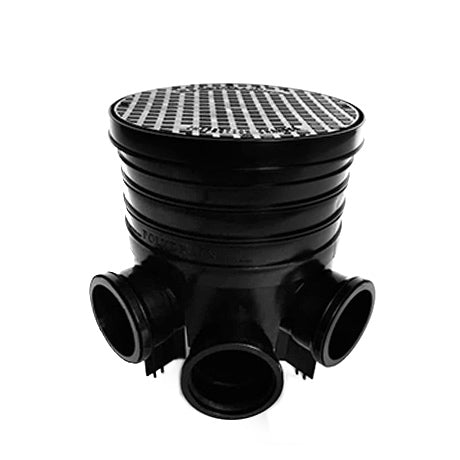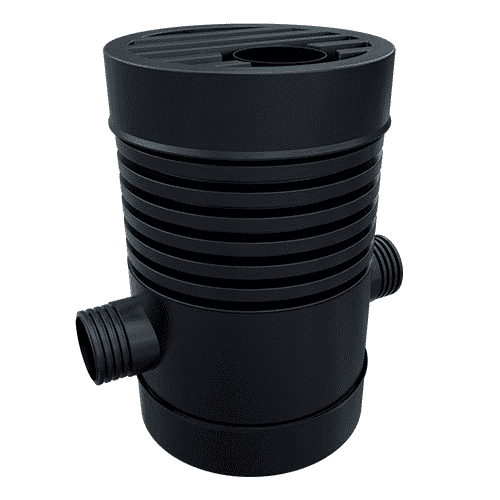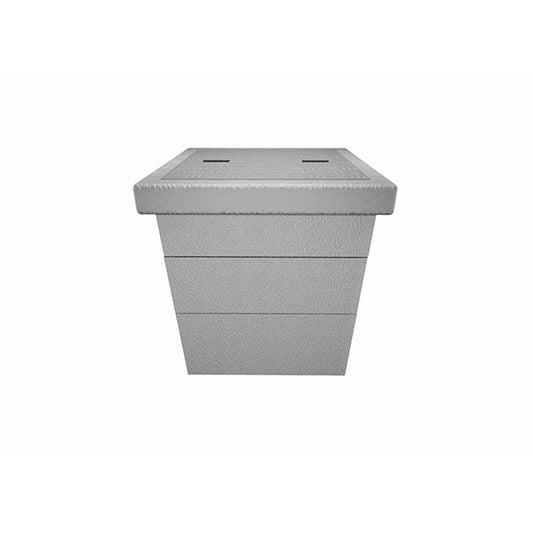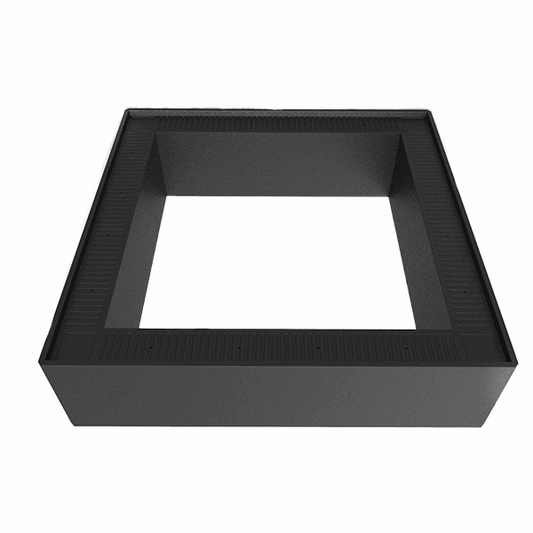So you know you need to install an inspection chamber but you have a few questions, such as what’s its actual purpose and what’s the difference between adoptable and non-adoptable inspection chambers. To bring you up to speed, we’ve put together this useful guide.
Contents
- What is an inspection chamber?
- When should you use an Inspection Chamber?
- What is the structure of an Inspection Chamber?
- How does it work?
- What’s the difference between an adoptable and non-adoptable inspection chamber?
- What are the choice of manhole covers?
- Which style of chamber is the best option – plastic or concrete?
- How deep should an inspection chamber go?
- Should a chamber be concreted in?
- Why are manholes and sewers considered dangerous?
- What is a Catchpit?
- What are the parts of an inspection chamber?
- Who is responsible for clearing blockages in inspection chambers?
- What do the acronyms SfA7, BS EN 1401-1:2009 and S EN 13598-2 mean?
- Can you move an inspection chamber?
- Where can your inspection chamber be moved to?
- Which inspection chamber should I choose?
- Where can I get expert advice on Inspection Chambers?
What is an inspection chamber?
An inspection chamber, which is commonly known as a manhole cover, is integral to an underground drainage system. It provides an access point to enable drains to be cleaned, cleared and inspected when required.
Inspection chambers are also used for safety purposes by preventing people from entering drainage systems without authorisation. In scenarios where access is needed, ‘confined space’ risk assessments and method statements must be prepared.
Manhole and inspection chamber guidance is governed by Building Regulations. You can find out more about this below, including what the acronyms SfA7, BS EN 1401 and S EN 13598-2 stand for.
When should you use an inspection chamber?
You will typically need to use an inspection chamber in the following instances:
- Where a branch pipe joins a main drainage run in the system
- When there is a straight run of piping over 22 metres long
- When a drain changes direction horizontally by more than 30 degrees
- When there is a change in pipe size
A key tip when installing a chamber though is to remember you will need to get a drain rod in every single part of the drainage system. If there is ever a blockage you will need to be able to do this!
What is the structure of an inspection chamber?
An inspection chamber is sectional and typically consists of a base, sectional risers with a seal, and a manhole cover in your desired finish. The risers sit on top of the base and the joint is sealed using an integral rubber seal. Subsequent risers can also be added to provide further height and sealed using an integral rubber seal again. The cover and frame sit on top of the risers at ground level.
How does it work?
The idea is simple. Designed for testing and inspecting underground drainage and clearing any blockages, whilst restricting unauthorised access, inspection chambers make it easy for you to solve any underground drainage problems effectively.
Though similar to manholes, they don’t allow physical entry. They are specifically designed for cameras and equipment only, i.e. drain rods, water jetting hoses and CCTV cameras for drainage surveys.
What is the difference between an adoptable and non-adoptable inspection chamber?
Typically, a chamber that serves two or more properties and connects to the UK public sewerage network is considered an adoptable inspection chamber. This may, however, vary depending on your local water requirements.
In contrast, non-adoptable inspection chambers are deemed to typically serve just one property and remain the responsibility of each householder.
What are the choice of manhole covers?
Manhole covers are used to secure inspection chambers and thereby prevent tampering and unwanted access. They are also used to cover the ground for safety purposes.
They come in a range of different shapes, sizes and materials. These include square, round, plastic, steel, recessed for block paving or slabs, and airtight covers for internal use. They’re also available in a selection of weight load classes so that they meet the required regulations to be installed in driveways, car parks and other trafficked areas. At Cotterill Civils, we provide a wide variety of manhole cover to suit your specific requirements.
Which style of inspection chamber is best?
Inspection chambers are manufactured in both High-Density Polyethylene plastic (HDPE) and precast concrete. They can be supplied in the following different styles: standard concrete rings, wide wall concrete rings, pre benched concrete chambers and prefabricated HDPE chambers. The best material for your application depends upon a number of variables. These include the diameter and depth of the chamber as well as whether man access is required. Another significant factor that will influence your choice of material is the actual size of the inspection chamber required.
How deep should an inspection chamber go?
This depends on the size of the chamber. There are generally two sizes of chambers: 450mm and 320mm in diameter. With the smaller chambers (320mm diameter) you can only use them to a depth of 600mm. If you go any deeper, it then becomes impossible to bend a drain rod when you come to inspect it for blockages. In contrast, the larger chambers (450mm) can be installed to a depth of 1.2m, although you can go down as far as 3m if you use a restricted access cover.
Should a chamber be concreted in?
According to regulations inspection chambers should be installed on suitable bedding material. If the trench is stable, it is advised that you install them on a bed of pea shingle around 150-200mm deep, and then use the pea shingle again to back-fill around it.
Why are manholes and sewers considered dangerous?
Manholes and sewers are considered to be exceptionally dangerous places. This is because noxious gases can be present that can injure and even kill. It is recommended that any work on live sewers is undertaken by a drainage specialist who has completed a ‘Confined Spaces’ and/or ‘Sewer Working’ safety course.
What is a Catchpit?
A catchpit is an empty chamber that is installed into a drainage system to prevent silt and debris from building up and causing blockages. They play a critical role in preventing the build-up of material that can cause pipe blockages, resulting in the backing up of water in the drainage system, which can lead to localised flooding. Catchpits are used in all wastewater management systems, including mainline sewers and stormwater drainage systems that are used to manage water along highways, railways, and large areas of hard surfacing.
What are the parts of an inspection chamber?
Inspection chambers can be supplied in three parts or as a whole system, depending on the manufacturer. Typically, there are three parts to an inspection chamber – the cover, the riser and the base.
- The cover, as described above in the manhole section, is used to protect the inspection chamber from unwanted tampering and for safety purposes.
- The riser is the mid-section of the system and it can come in a range of different heights. The riser sits on top of the base. Connected with rubber seals, the riser adds the right amount of height so that the inspection chamber cover sits better at the surface. They are generally designed to be easily cut to size.
- The base is the ‘bottom’ section of the inspection chamber that’s closest to the drain pipes. The base typically accepts pipes, either 110mm or 160mm in diameter. Inspection chambers can be supplied with various inlet sizes depending on your requirement. If you have more inlets than pipes you can use a blanking plug.
Who is responsible for clearing blockages in inspection chambers?
It’s important that inspection chambers and manholes are kept clear of blockages to ensure clear access to underground drainage systems at all times. One of the first signs that you may have a blocked drain is if your toilet or bath fails to drain quickly and efficiently, or you spot an overflowing inspection chamber or gully.
Who is responsible for clearing blockages depends on whether your inspection chamber is adoptable or non-adoptable. If it serves only your property, you are responsible for its maintenance whereas if it serves more than one property and connects to the local sewer network, it is likely to be the responsibility of your local sewage and water company.
Inspection chambers are however dangerous to enter so you should always use a specialist to clean it.
What do the acronyms SfA7, BS EN 1401-1:2009 and S EN 13598-2 mean?
SfA7 is an abbreviation of Sewers for Adoption 7th edition, 2012 (SfA7). BS EN 1401-1:2009 is the British and European Standard for plastics piping systems for non-pressure underground drainage and sewerage. BS EN 13598-2 is the plastics piping system for non-pressure underground drainage and sewerage.
Can you move an inspection chamber?
In some circumstances you might consider whether you can move an inspection chamber (if you’re planning an extension for example, of if the manhole cover is in a prominent or awkward position in your garden).
It can be possible to arrange for an inspection chamber to be moved, but there are a few things to think about:
Check whether your inspection chamber is on private or public land
You can find out whether your chamber is installed on your land by either locating the inspection chamber yourself, or by contacting your local council for building plans. Some may charge a small fee.
Inspection chambers have plastic or metal covers that prevent unwanted access or blockages from entering. They will most likely be located in your garden or driveway.
Inspection chambers installed on your land can be moved – manholes connected to the public sewer line cannot as they are maintained by the water company.
However, it’s not uncommon for neighbours to share the same sewer line. You can find out whether this is the case by contacting your local water authority.
In this instance, you will have to speak to your neighbour about moving the chamber.
Where can your inspection chamber be moved to?
Your new inspection chamber must comply with the standard rules for installing a new chamber that were explained earlier.
Remember, you cannot build over an inspection chamber, so be sure to consider this when installing one.
Which inspection chamber should I choose?
Hear from our Commercial Director on the best options when choosing an inspection chamber:
Where can I get expert advice on inspection chambers?
We appreciate that inspection chambers are very sought after products and, with so many options to choose from, knowing which to choose can be difficult.
At Cotterill Civils, we supply a wide range of inspection chamber and will be more than happy to advise you on the most suitable solution for your needs. We can even recommend which inspection chamber components are best for your budget. So, what are you waiting for?

































